![]()
HISTORY OF BINGHAM
THE ANGLO-SAXONS
Excavations at Margidunum have revealed little evidence of what happened there in the late 4th and 5th centuries. There is very little late 4th century pottery and only one building that may date from this period. A gilt-bronze pendant (see photo below), found in Margidunum has the distinctive style of relief decoration that dates it to the fifth century and employs motifs and techniques more Romano-British than Germanic in character. That Roman art styles continued to develop in this period suggests either that at least part of the local population survived the Anglo-Saxon invasions or that there was a hiatus here between the departure of the Romans and the arrival of the Anglo-Saxons; the fineness of the object indicates a person of some status, and suggests that Margidunum remained important for some time after the end of Roman rule.
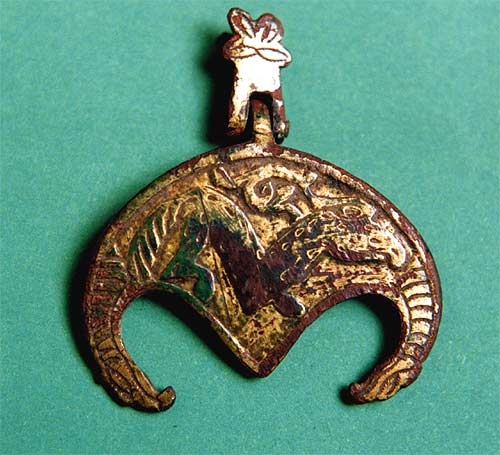
Gilt-bronze pendant found in Margidunum, is possibly from a horse harness. Its design is thought to be more Romano-British than Germanic and has been attributed to the fifth century (Nottingham University Museum. Photo: R. J. A. Wilson).
An Anglo-Saxon broach (drawn in 1909) (see photo below) found at Margidunum probably came from a female burial in a cemetery, though its find spot and date are unknown. This suggests that eventually, Margidunum did become an Anglo-Saxon centre. The likelihood is that after 410AD the British residents tried to continue living as they had done under Roman rule, but that at some time later, possibly late in the 5th or early 6th centuries, Anglo-Saxons arrived in the area and brought change with them.
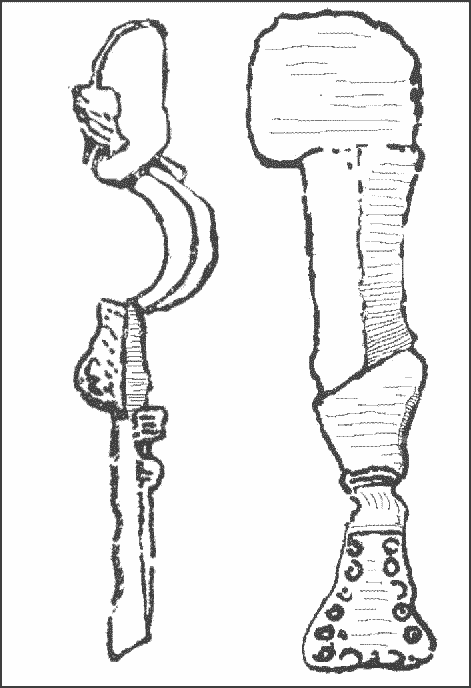
Bronze brooch found at Margidunum. The iron pin has corroded away. Height 6.7 cm; side view to the left. Original drawing by W.R.Gleave in 1909. Redrawn by G. Kinsley.
Following the withdrawal of the Roman Army from England the pottery industry, which was highly commercialised, could not be sustained and the remaining population fell back to producing pottery that is indistinguishable in quality from that made in the Iron Age. It does not survive well when exposed to the elements in plough soil. Where sherds are found, they are likely to indicate the proximity of settlements. The method of dating Anglo-Saxon pottery relies mainly on decoration. If the pottery is undecorated little can be said of it other than it falls in the date range 450-800AD or 550-800AD depending on the fabric type. None of the pottery recovered while field walking was decorated.
Scatters of Anglo-Saxon pottery have been found in four areas, all of them alongside places where there are concentrations of Iron Age and Roman pottery (see Figure 3.24). There is a significant scatter in the fields immediately to the south east of Margidunum, suggesting continuity of occupation here, but the widest scatter is around Lower Brackendale Farm. Several sherds have been found at Granby Lane and two near the double-ditched enclosure on Starnhill Farm. Other than that there are two sites where a single sherd has been found. This distribution is in marked contrast to the Roman pottery, which is widely scattered over the whole parish. Even though the Anglo-Saxon pottery is much less durable than Roman pottery its complete absence in many areas seems to indicate a major change in agricultural practice from widespread, probably commercial arable farming to self-sufficiency around each individual settlement.
No Anglo-Saxon pottery was found on Parson’s Hill, but there is an Anglo-Saxon burial site here. Weaponry, a spear point and a shield boss, found in the grave in 1863 was known for a long time to have been kept in the Bingham Rectory, but has since disappeared. It is likely to date from about 500-700 AD. The presence of weapons indicates a free-born male burial of the warrior class. Farming practices on this farm, where the land is not ploughed, but worked with a cultivator that disturbs only the top few inches of soil, make it unlikely that Anglo-Saxon pottery turned up twenty years ago when the field was last ploughed would survive. This raises the possibility that there was an Anglo-Saxon settlement site here and continuity of occupation from the Iron Age.
None of the sites with small clusters of Roman pottery in the southern half of the parish contain Anglo-Saxon pottery. So it seems that only the well-established communities that had roots in the Iron Age persisted after the departure of the Romans. Whether or not the people living in them were Anglo-Saxon immigrants or British or both cannot be established.
An Anglo-Saxon cremation cemetery is known to the north of Starnhill farmhouse. A good deal of pottery and burnt bone were found on the surface by field walking in the early 1970s, though it has not been dated.
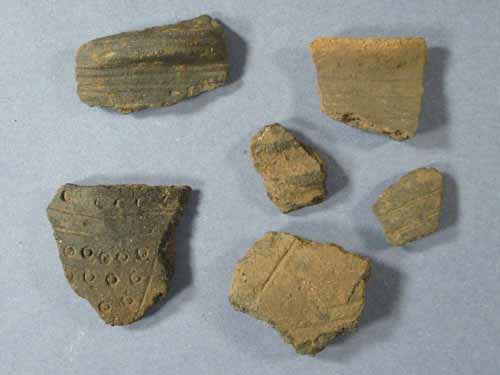
These small sherds, collected by Trent & Peak Archaeological Unit from the surface of fields in the parish are the tantalising evidence for Anglo-Saxon occupation in Bingham. These are from hand-made urns decorated with applied cordons and bosses or by impressing stamps made from bones and other materials. Nottingham University Museum Photo: Robin Aldworth
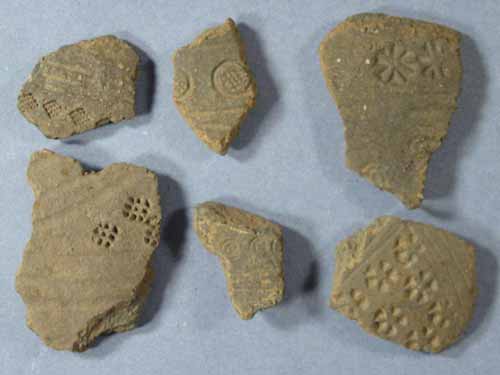
The stamped decoration on these Anglo-Saxon sherds is fairly elaborate. Quite complex stamps have been made to enhance the urns. These were collected by Trent & Peak Archaeological Unit from the surface of fields in the parish.
Nottingham University Museum Photo: Robin Aldworth
Such finds are likely to come from a cremation cemetery where, after the burning of the body on a cremation pyre, the bones of the dead person were scooped up together with the remains of any grave goods, and placed in a pottery urn. The invading Anglo-Saxons imported this form of burial and it is likely that the cemetery would have been a central burial place for the new settlers.
A tumulus, ( use http://www.binghamheritage.org.uk/history/anglo_saxon_tumulus.htm from the Anglo-Saxon page of the old site and keep caption) sited on the Fosse Way, near the Moothouse Pit and described by the antiquarian William Stukeley in 1726 , is thought to have been an Anglo-Saxon burial mound. The burial-mound and its isolated hilltop location are typical of the burials of pagan Anglo-Saxon chieftains; providing a durable mark in the landscape, a symbol of authority visible from miles around. It is likely to date from the 600s. Its exact location is unknown, but excavations carried out in 2009 along the line of the new A46 may have found it. (A report is awaited)
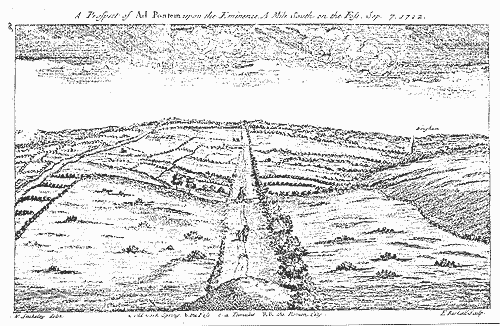
Bingham from the Fosse Way tumulus drawn in 1722 by William Stukeley. From an engraving in Itinerarium Curiosum.
The absence of any indication of an Anglo-Saxon presence in the area of Bingham town is puzzling. Nothing indicating Anglo-Saxon occupation has been found at Carnarvon Primary School, where there was a Romano-British farm or villa, or anywhere else in the current town of Bingham, but the name Bingham, said to be a contraction of Bynna-ing-ham- the place (ham) of the people (ing) of Bynna seems to suggest that there was an Anglo-Saxon settlement here, possibly close to where the present church is.
The evidence at hand seems to suggest that after a period following the departure of the Romans when the area continued to be occupied by the resident British population, the Anglo-Saxons came into the area and took control. The presence of Anglo-Saxon pottery sherds in places close by sites that were important in the Iron Age and Roman period suggests some sort of continuity there. Perhaps the British peasants continued to live as they always had done, with only the leadership of the community changing.
